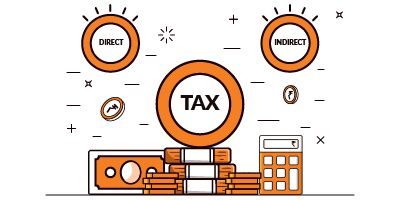What Are Taxes?
Taxes are mandatory contributions levied on individuals or corporations by a government entity—whether local, regional, or national. Tax revenues finance government activities, including public works and services such as roads and schools, or programs such as Social Security and Medicare.
In economics, taxes fall on whoever pays the burden of the tax, whether this is the entity being taxed, such as a business, or the end consumers of the business’s goods. From an accounting perspective, there are various taxes to consider, including payroll taxes, federal and state income taxes, and sales taxes.

A direct tax can be defined as a tax that is paid directly by an individual or organization to the imposing entity (generally government). Whereas, Indirect taxes are basically taxes that can be passed on to another entity or individual.
Understanding Taxes
To help fund public works and services—and to build and maintain the infrastructure used in a country—a government usually taxes its individual and corporate residents. The tax collected is used for the betterment of the economy and all who are living in it.
Tax revenues are used for public services and the operation of the government, as well as for Social Security and Medicare.1 As the large baby boomer generation has aged, Social Security and Medicare have claimed increasingly high proportions of the total federal expenditure of tax revenue.
A tax requires a percentage of the taxpayer’s earnings or money to be taken and remitted to the government. Payment of taxes at rates levied by the government is compulsory, and tax evasion—the deliberate failure to pay one’s full tax liabilities—is punishable by law. (On the other hand, tax avoidance—actions taken to lessen your tax liability and maximize after-tax income—is perfectly legal.)
Most governments use an agency or department to collect taxes.
Types of Taxes
There are several very common types of taxes:
- Income tax—a percentage of generated income that is relinquished to the state or federal government.
- Payroll tax—a percentage withheld from an employee’s pay by an employer, who pays it to the government on the employee’s behalf to fund Medicare and Social Security programs.
- Corporate tax—a percentage of corporate profits taken as tax by the government to fund federal programs.
- Sales tax—taxes levied on certain goods and services; varies by jurisdiction.
- Property tax—based on the value of land and property assets.
- Tariff—taxes on imported goods; imposed with the aim of strengthening domestic businesses.
- Estate tax—rate applied to the fair market value (FMV) of property in a person’s estate at the time of death; the total estate must exceed thresholds set by state and federal governments.
Tax systems vary widely among nations, and it is important for individuals and corporations to carefully study a new locale’s tax laws before earning income or doing business there.